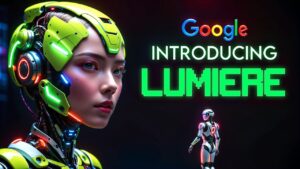LUMIERE AI in the Classroom: A New Era of Visual Learning

AI is reshaping education, and as teachers it is better to work with it instead of against it, because quite honestly it’s not going anywhere! I personally have dabbled in using text to image AI programs through Twinpics.AI, using this I was able to challenge students to use descriptive writing to match an image. Looking through the different Generative AI list, I wondered how much further it goes, and that’s when I decided to explore LUMIERE AI, a text-to-video and image-to-video generator developed by Google DeepMind. This tool allows users to create cinematic-quality videos from simple text descriptions or static image. Exploring this resource got my wheels turning of how this technology fits into the classroom, and what are the implications for teaching and learning?
Enhancing Teaching and Engagement
I found that LUMIERE AI presents many opportunities for both educators and students. For teachers, it can serve as a dynamic instructional aid, turning concepts into engaging visual narratives. I thought about how difficult it is to engage students in history and science at times, and imagine demonstrating historical events through AI-generated reenactments or illustrating scientific processes with animated sequences. I know this would be much more engaging for me as a student and this kind of visualization could potentially make learning more accessible for students who struggle with text-heavy materials.
After collaborating with some of my coworkers about what this program could be used for we came up multiple ways that it would enhance learning. For ELA or Creative Writing class, students could turn their short stories into animated videos, which would deepen their understanding of narrative structure and visual storytelling. In Social Studies, students might create AI-generated documentaries on historical figures or cultural traditions. By integrating AI into projects, students not only engage with the material more interactively but also develop essential digital literacy skills.
Beyond engagement, LUMIERE AI can foster critical thinking. Students could analyze and refine their prompts to generate videos that align with their vision, encouraging them to think critically about the relationship between text and imagery. They can also evaluate the accuracy of AI-generated content, sparking discussions on media literacy, misinformation, and the ethics of AI-generated visuals.
Ethical and Practical Considerations
While LUMIERE AI has potential, its implementation comes with challenges, as does any AI tools. Ethical concerns could include the possibility of bias in AI-generated content and the risk of deepfake-style misinformation. Teachers must guide students in critically assessing AI-produced materials, ensuring they understand the difference between authentic and AI-generated media.
The Future of AI in Education
As AI continues to evolve, tools like LUMIERE AI will likely become more prevalent in education. They offer new ways to engage students, assess understanding, and support diverse learning needs. However, successful integration will require thoughtful implementation, ethical awareness, and a balance between AI-generated content and traditional teaching methods.
In my perspective, AI should be seen as an enhancement, not a replacement, for human-driven teaching. If used wisely, it can empower students to become more engaged, creative, and critical thinkers. As educators, we must remain adaptable, leveraging AI’s benefits while ensuring that students develop the skills to navigate an increasingly AI-driven world.
3 thoughts on “LUMIERE AI in the Classroom: A New Era of Visual Learning”
This is so interesting to me! Did you use it to create a video? I’m curious how it went!
This is so cool – I have heard of it before (or many of the AI tools we talked about in class lol!). LUMIERE sounds like such a cool way to make learning more engaging – especially for visual learners!! I really like how you’re thinking about both the creative possibilities and the ethical side of things. Since this blog prompt, I have been trying to figure out how to teach the ethics associated with AI and came across this site: https://ai4k12.org/! I like the Big Ideas and the Resources sections!
This was such a thoughtful and inspiring post, Samantha! I love how you’ve embraced AI like LUMIERE as a creative tool with students rather than something to be wary of. The idea of turning student writing into animated videos or using AI for historical reenactments is brilliant—it would’ve made me so much more excited to learn back in school!
I also appreciate how you’re thinking about the ethics side. Teaching kids to be critical consumers of AI-generated content is just as important as teaching them how to use the tools. Thanks for sharing these ideas—definitely got my wheels turning too!